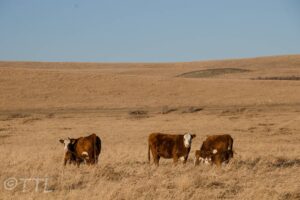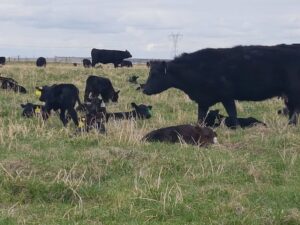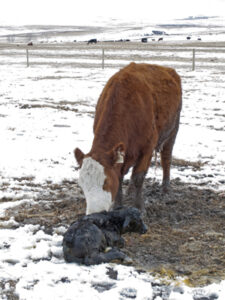How Fresh Pens and Pastures Prevent Calf Losses
Whether it is the Sandhills Calving System or a variation, the objective is the same.
Doug Wray believes in keeping newborn calves separated as much as possible from other two-week and older calves on his south-central Alberta farm to avoid livestock congestion and dramatically reduce the risk of congregated calves developing and spreading scours. And for the past several years the plan has worked.
Wray, who along with family members operates Wray Ranch near Irricana, north of Calgary, has developed this calving-on-pasture system over the past 10 years. In his year-round grazing system, his herd of about 300 bred cows moves onto grass about May 10. They actually begin calving May 1 on swath grazing and then by May 10 the pregnant cows move to grass and the first batch of cows-with-calves stay behind.
The first grass pasture is 160 acres in size, divided into eight 20-acre paddocks.
“The herd is managed in one group on pasture for about two weeks before we make the first split,” says Wray. At roughly the first two-week mark cows with calves (usually about 120 head) “are taken to fresh pasture in one direction, while the bred cows head to new grass in another direction,” he explains. Wray essentially runs two herds at calving season. One group of pregnant cows, that get’s smaller with each passing week, and one group of cow-calf pairs that get’s larger over the calving season. The pregnant cows are managed on one quarter divided into paddocks, while the cow-calf pairs are managed on another quarter about three-quarters of a mile away. That quarter is also divided into paddocks.
The timing of each split of the herd — separating pregnant cows from cow-calf pairs — is determined by “it depends”, says Wray. Part of the decision is based on how fast grass is growing and the other part on how many cows have calved. “On average once we get into mid and later May we are probably making a split every three or four days to a week,” says Wray. “If the grass is really growing we move faster and if it is slower we may delay the move.”
“It is very much a read and react approach,” says Wray. On the pregnant herd quarter he’s looking to move that group to new grass at least once a week. Pregnant cows are removed from any cow-calf pairs and the pregnant cows go into to a new paddock. The cow-calf pairs remain behind. Once he has somewhere between 50 and 75 cow-calf pairs in a paddock on the pregnant-herd side of the rotation, he trails those cow-calf pairs over to the pair’s quarter section where they join earlier cow-calf pairs.
And of course with each split the pregnant cow numbers are getting smaller while the cows-with-calves group is getting larger. But it is a parallel system with each group moving to new ground every few days to about a week. “The overall principle is to keep both groups of cattle moving to fresh ground,” says Wray. “Quite often we have an environment where we have plenty of fresh growing grass and the sun is shining, and it is very favourable conditions for calving. If we run into a couple days where it is cold and wet we won’t move a group of new cow-calf pairs from the pregnant herd side of the rotation over to the pairs-rotation. We’ll wait. But generally if we have nice sunny conditions there hasn’t been a problem moving pairs from one rotation over to the other and mixing them with older calves. But again, even the pairs’ side is moving to fresh ground about once a week.”
The rotation is good for calf health and it also fits with Wray’s pasture management objectives — as grass is rapidly growing he likes to move cattle through quickly to take the first clip off before they return later in the season.
The herd’s breeding season usually runs about 54 days, so the length of calving season is typically one week on either side of that period. “Once we get to early June we may only have 20 head or so left to calve,” says Wray. By the end of calving season, the herd will be regrouped in a main herd of cow-calf pairs to continue through a rotational grazing system for the summer.
“Our primary objective is to keep new born calves from being all bunched together and to make sure we’re always calving on fresh ground,” says Wray. The system has produced excellent results from a calf-health standpoint.
“Scours and some of the other new born calf issues such as respiratory disease, just aren’t a concern,” says Wray.
He was a bit concerned by the late spring of 2018 — cows were just beginning to calve as snow was melting — but the system worked well again. The herd was swath grazing close to the corrals right up to calving. But just as calving started he moved the herd to a nearby quarter section of grass not far from the cattle handling facilities.
“Our primary objective is to keep new born calves from being all bunched together and to make sure we’re always calving on fresh ground.”
“The snow stayed right up until calving, so ground conditions were fairly wet,” he says. “I figured if there were any problems on pasture, the herd was close enough that I could bring anything that needed attention over to the corrals. There were maybe half a dozen we had to bring back because cows had swollen udders or really large teats and the calves couldn’t nurse, but no scours.”
Wray says his management strategy for healthy calves is to keep newborns separated from older calves and always keep the calving herd moving to new ground a build up of disease bacteria. “The system seems to work well for us because we are calving later, calving on pasture and we are also moving cattle to make sure they have fresh grass,” says Wray.
THE SANDHILLS CALVING SYSTEM
While this might be dubbed the Wray Calving System, it is also aligns as a variation of a system developed at the University of Nebraska about 20 years ago, known as the Sandhills Calving System (developed on pastures in the Sandhills of Nebraska).
The Sandhills system was designed to protect calf health by providing separation between newborn calves and older calves (two weeks of age and older) during a critical time of the year when the risk of disease development, primarily scours, is high. Many Canadian veterinarians and other animal health specialists are encouraging more producers to consider the Sandhills Calving System or some variation to reduce the risk of calf losses due to disease.
Dr. Elizabeth Homerosky, a veterinarian with Veterinary Agri-Health Services in Airdrie north of Calgary, regularly recommends the Sandhills Calving System or modifications thereof to her clients.
Newborn calves co-mingled with older calves, particularly if they are concentrated in a relatively small area, and particularly if weather conditions are cool and wet is really the ideal scenario for the development of a scours outbreak in a cowherd.
“The traditional Sandhills system has been proven to be effective in reducing the risk of scours in calves,” says Homerosky. “But an important consideration is that it takes some planning.”
Research has shown the cycle of scours at calving often originates with mature beef cows as they carry the scours pathogen. Scour pathogens are viruses, bacteria and microscopic parasites. Cows shed the pathogen on the ground in manure. Newborn calves often pick up the pathogen and may not become sick, but their guts serve as pathogen-multipliers. These calves shed an increasing load of pathogen onto the calving ground, then newborn calves come along and pick up the heavy load of the bacteria. The dose-load of pathogens overwhelms the calf ’s ability to resist disease, and suddenly the beef producer is dealing with a bunch of sick calves. And if a beef herd calves on the same area year after year, the soil can also be contaminated with scour-causing pathogens. So by keeping the more vulnerable newborn calves on clean ground away from the higher-risk two-week and older calves, the risk of a scours outbreak is greatly reduced.
Back to the planning part as producers consider developing a Sandhills Calving System.
“Among the first considerations — producers need to have enough land available to handle each group of cows and calves over the calving season,” says Homerosky. “The herd should be split about every two weeks with the cows that haven’t calved moved to a fresh pasture.” If a producer has a 60-day breeding season, for example, they would need to have planned for five pastures with adequate holding capacity.”
She often works with producers to develop a pasture chart to handle cattle numbers. If the producer has 300 head of bred cows, for example, the starting #1 pasture needs to be large enough to accommodate the whole herd and first batch of calves for two weeks. Pasture #2 needs to be large enough to hold the estimated number of cows still to calve for another two weeks and so on.
Homerosky says proper fencing to provide separation of the calved and to-calve herds is important. She says a single strand electric wire to divide pastures usually isn’t sufficient as calves can cross under the wire and mix.
Another important planning aspect includes providing adequate water for each herd in their respective pastures. Depending on calving season dates, water may need to be available quite early in the spring.
Homerosky says newborn calves are most vulnerable to some of the scour-causing pathogens within the first weeks of life, but their immunity grows as each day passes, provided they received adequate and good quality colostrum at birth. Once calves reach about four weeks of age their immunity system has developed sufficiently to fight most scour-causing pathogens.
While the original Sandhills Calving System involves a pasture sequence that leaves cow-calf pairs behind as the yet-to-calve cattle are moved to fresh ground, there are variations that work, as well.
Doug Wray described a pasture calving system that works for his operation. Homerosky says she has also worked to develop a modified Sandhills calving system with producers who prefer to the keep the calving herd close in to corrals and calving facilities and move the cow-calf pairs to new ground. These may be smaller beef operations, purebred producers, or farms with a smaller land base.
“I often refer to it as the Foothills Calving System,” says Homerosky. This variation is just the reverse described in the Sandhills system. The bred cowherd is held in one pasture or calving area, and as soon as calves begin to appear, cow-calf pairs are moved to the next area or nursery pasture.
Under the Foothills system, Homerosky recommends cow-calf pairs be moved away from the main pregnant cowherd within 24-hours of calves being born
Under the Foothills system, Homerosky recommends cow-calf pairs be moved away from the main pregnant cowherd within 24-hours of calves being born. For example, if 10 calves are born today, as soon as they have nursed and are ambulatory move that group to the new paddock or first nursery pasture within 24 hours. If 10 calves are born tomorrow, do the same thing — move those pairs into the paddock or nursery pasture to join up with the first day’s calves. Ideally she recommends following this approach for about 10 days (no more than two weeks). Keep moving cow-and-newborn-calf pairs into that first nursery pasture for 10 days to two weeks (or before if the pasture reaches capacity). At the 10 day to two-week mark start moving cows and newborn calf pairs to fresh ground in a new second nursery pasture and continue using it for 10 to 14 days before starting a third nursery pasture.
“Newborn calves do not shed any scours pathogens in their manure within the first 24 hours of life, so that’s why it is important to move those calves within 24 hours,” says Homerosky. By moving the pairs it limits their exposure to any pathogens that may be present around the main cowherd and they are also not adding to the pathogen load in the calving area.
If by some chance a case of scours does develop, the Foothills systems allows a producer to contain or manage the outbreak to within a small group of animals, rather than whole herd.
Claire Windeyer, a veterinarian and associate professor at the University of Calgary has seen these systems work extremely well. “It is really all about providing the newborn calf with a good environment,” says Windeyer. “It does take proper planning and management and time on the part of the producer but getting those calves to a clean environment is the best means of reducing the risk of calves developing scours. No system provides a 100 per cent guarantee but it certainly increases the odds of a raising a healthy calf.”
If by some chance a case of scours does develop, the Foothills systems allows a producer to contain or manage the outbreak to within a small group of animals, rather than whole herd.
As most producers know, scours or other early calfhood diseases such as pneumonia not only reduce calf performance, but often result in death and those add up to an economic loss to the producer.
Results of the 2014 Western Canada Cow-Calf Survey (WCCCS), for example, reported that scours and pneumonia accounted for about 30 per cent of calf deaths. The 2017 WCCCS survey reported similar losses with about 25 per cent of calf deaths attributed to scours. Taking it a bit further, other Canadian beef industry research showed while calves treated for scours can survive, their performance is compromised, resulting in weaning weights anywhere from 15 to 30 pounds lighter than counterparts that didn’t get sick. And still other industry research calculated the overall cost of calf death loss, treatment costs, and reduced performance in a 100 head beef herd with a 20 per cent incidence of scours resulted in a $40 per head cost per bred cow or about $4,000 in that year.
“Implementing some version of this calving system does take time and labor,” says Windeyer. “But if a beef operation appears to be struggling with some degree of scours every year it may be well worth considering. It might only take having a couple more calves to wean in the fall to cover the cost of the time and management required to reduce the risk of scours.”
Click here to subscribe to the BCRC Blog and receive email notifications when new content is posted.
The sharing or reprinting of BCRC Blog articles is welcome and encouraged. Please provide acknowledgement to the Beef Cattle Research Council, list the website address, www.BeefResearch.ca, and let us know you chose to share the article by emailing us at info@beefresearch.ca.
We welcome your questions, comments and suggestions. Contact us directly or generate public discussion by posting your thoughts below.


